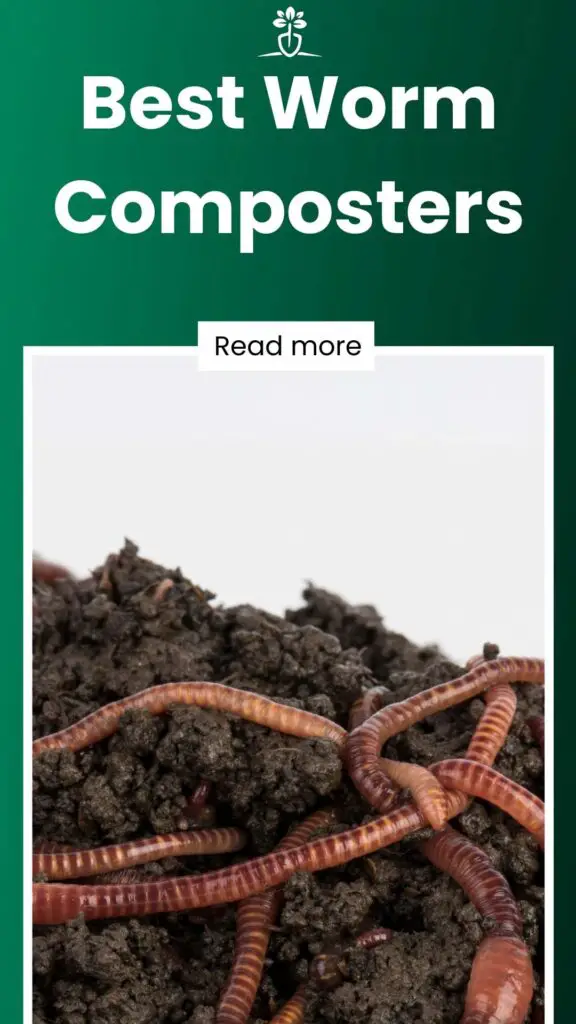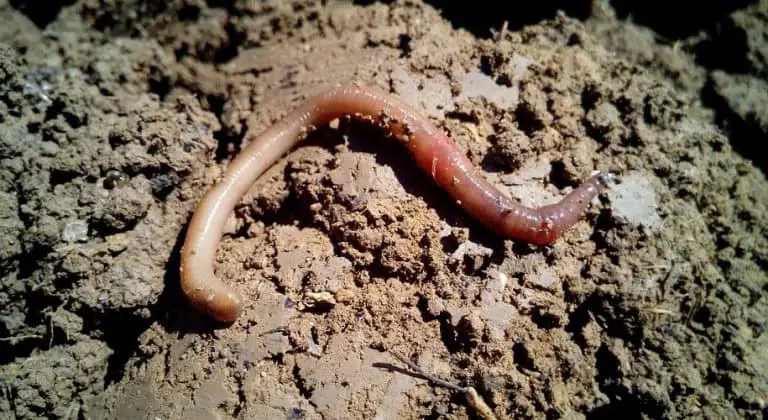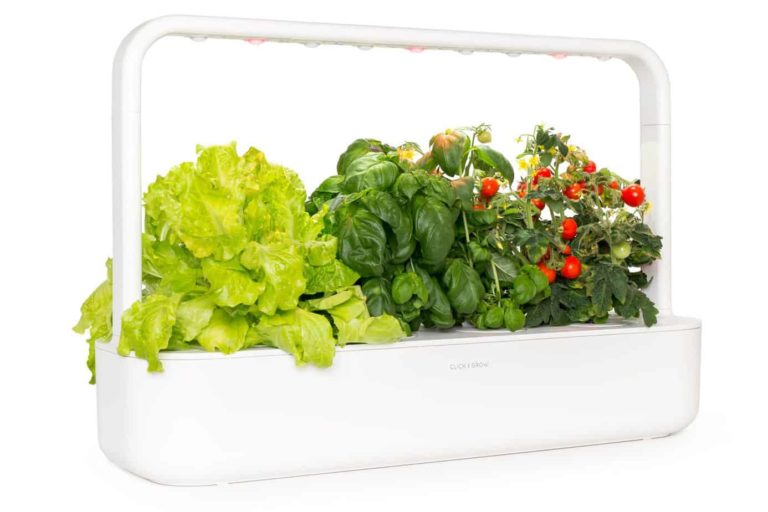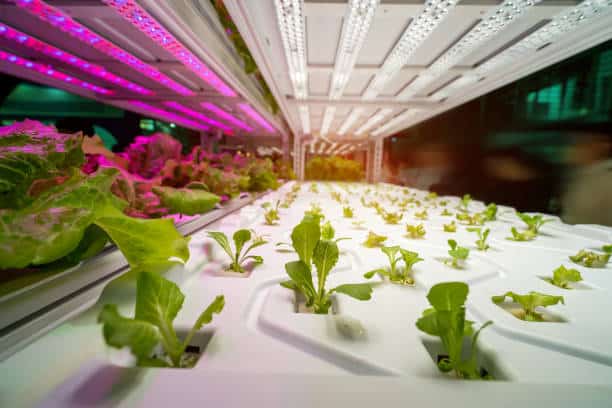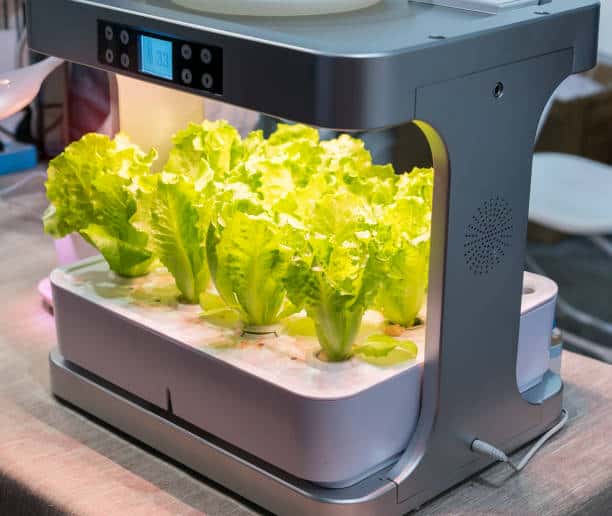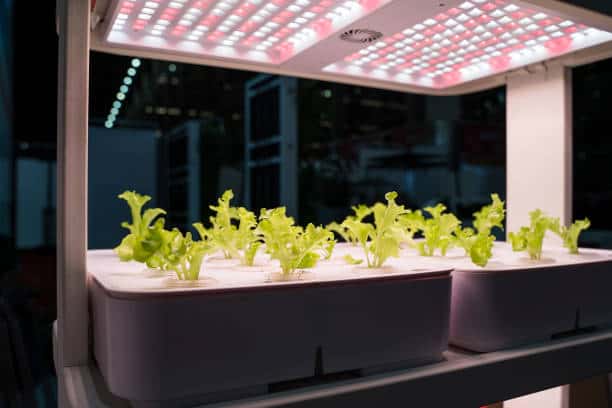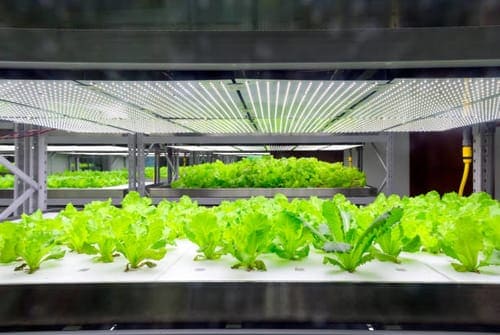Best Worm Composters
For those constrained by space or time, a composting worm bin is a highly beneficial tool. Traditional compost piles require substantial land, need to be turned frequently, and can generate unpleasant odors. However, using worms for composting eliminates the need for frequent pile turning and enduring unpleasant odors.
Worm composters come in small compact sizes that allow you to recycle your kitchen waste and other organic material into fertilizer. All you have to do is feed the worms, and collect the castings. But how do you know which one’s best for you? We have reviewed some of the best in the market. We have also included some tips that will help you use your worm bin effectively.
Contents
Top 5 Worm Composting Bins
1. Worm Factory 360 Composter
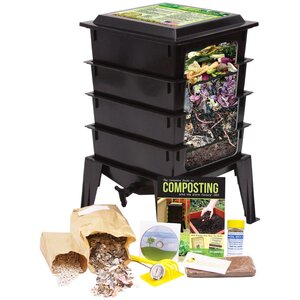
Key Features
- You can stack up to trays to produce a lot of worm compost.
- The manufacturer offers a 5-year warranty.
- The structure is made from recycled plastic and comes in green, terracotta, and black colors.
- The manufacturer also offers worm bedding materials such as pumice and mineral rock dust.
Worm Factory 360 is an all-in-one multiple-track worm composting system. You can extend its capacity to ensure that you create as much vermicompost as possible. It also comes with some tools that allow you to ensure effective worm action. These include a scraper, a hand rake, and a moisture meter.
Why we like it
- It’s easy to collect the worm tea since this system features an inbuilt tray and a tap that allows you to drain the tea.
- The eight trays provide a large volume of vermicompost and offer more storage space for the produced compost.
- It has a very sturdy built, allowing you to empty each tray without toppling the whole structure.
- It is relatively odorless, enabling you to use it both indoors and outdoors.
What we don’t like
- It’s not easy to move it around. You have to remove the trays for you to move it from one place to another.
- Also, the worm tea is relatively not that effective.
Our Verdict
If you’re looking for a heavy-duty worm composter, the worm bin 360 would be great for you. You can adjust the number of trays based on the amount of space you have.
2. Hungry Bin – Continuous Flow Worm Composter
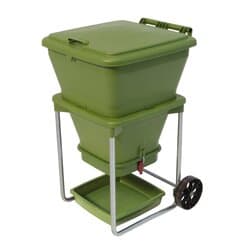
Key Features
- It features a one-container design.
- It also has wheels.
- The worms can consume 4.5 pounds of organic material per day.
- At the bottom, there’s a worm tea and castings collecting tray.
- It uses red wigglers, which facilitate the composting and the continuous flow where the used castings are naturally pushed down where you can easily extract them.
This is another expensive but excellent worm bin. Unlike most of the models that use trays, this system features one large container. It’s a continuous composting system that mimics a traditional composting heap, only it is ergonomically designed so that you don’t have to turn the scrap manually.
Why we like it
- It has wheels and handles that make it easier to move it around.
- The continuous flow is also quite effective at creating vermicompost.
- It has a compact design that enables it to fit in smaller areas.
What we don’t like
- This system is built with temperate environments in mind. If you live in other parts of the world, make sure you place it in the shade when it’s too hot, and place it indoors during winter.
- It’s also costly.
Our Verdict
If you don’t want to deal with trays anymore, this one’s for you. The handles and wheels ease mobility since you have to keep moving it around as the climate changes. Overall, it’s easy to maintain, and it will provide a steady supply of compost for your garden.
3. Worm Factory DS3BT
Key Features
- It features three trays, but you can stack up to seven trays for maximum production.
- It features a tap and a worm leachate collecting tray.
- The manufacturer also provides a DVD and a manual to help you in the assembly and using process.
This is a smaller and cheaper version of the Worm Factory 360 Compost. As you’d expect, most models from this company are usually of high quality. It’s also ideal for those who enjoy conserving the environment since it’s made from recycled plastic.
Why we like it
- Unlike some models, the manufacturer provides a very detailed guide through the video and instructions book.
- The worms move naturally to the upper trays, separating themselves from the compost. This process makes harvesting easier.
- The stackable design makes it easier to maximize compost production.
- It also doesn’t release bad odors during the composting process.
What we don’t like
- The lid is also ineffective. It attracts fruit flies and may leak water into the system.
- The plastic built is also not that sturdy.
- The spigot/tap is also flimsy. For some customers, it caused an accumulation of moisture in the worm bin, killing the worms. Others complained that it leaks the leachate.
Our Verdict
Due to its compact, tabletop design, it would make an excellent indoor worm bin. To get the most out of it, place it in the shade, especially when it’s about to rain. You can also regularly clean the tap and drain the leachate to prevent moisture from accumulating.
4. Worm Farm Composter
Key Features
- It features two trays. When the worms finish with one of them, they move to the next one.
- It also has a valve that allows you to drain the worm tea.
- The trays are made of plastic, while the stands are made of wood.
- It also features a lid that allows you to place in concealed places such as apartments. You can create holes on these lids to facilitate airflow in such areas.
This is one of the most expensive worm bins, but its functionality and ease of use are worth the hefty price. It also comes in a compact size that makes it ideal for indoor worm composting.
Why we like it
- The worm tea collector and tap help maintain the ideal moisture in the worm composting bin. You can use this worm tea on other potted plants.
- It’s straightforward to assemble and move around the house.
- It also looks great, blending in with other decorative items you may have.
What we don’t like
- The instructions may not be that straightforward, especially for a novice worm composter. For instance, the scraps should be placed continuously on the top tray, so that the worms can naturally move to it.
- Some customers complained about it being quite messy. Sometimes the worms may escape, or the worm tea valve fails to work. However, in case of any issues, their support is always ready to help you out.
Our Verdict
The Worm Farm Composter is worth considering if you’re looking for a simple worm composting bin that you can use in your kitchen. It’s smaller, good looking, and practical. You may come across some defects, such as excess worms, worms escaping, or defective parts. In such a scenario, don’t hesitate to contact the manufacturer. They will help resolve the issues.
5. VermiHut 5-Tray Worm Compost Bin
Key Features
- It’s a 5-trays worm composting system.
- It also features a lead with holes that facilitate airflow and ensure optimum moisture for the worms to thrive.
- Each tray has an M-board, or a worm saver, that prevents the worms from falling off the tray.
- The whole structure weighs 16 pounds.
- The manufacturer offers a 5-year warranty.
This VermiHut worm bin features an innovative design that ensures optimum air circulation and bad odor reduction. Also, worms automatically move to the next trays once they complete composting the heap on one shelf. You don’t have to remove the worms manually.
Why we like it
- The five trays provide a considerable amount of vermicompost.
- It’s easy to use. All you need to do is just add the scraps from your kitchen or any other organic materials.
- The air circulation mechanisms enhance its efficiency and minimize the bad odors, allowing you to use it indoors and outdoors.
- It composts at least 5 pounds of scrap per day.
What we don’t like
- Its plastic built is fragile. If you fill the trays with scraps, the legs may bow, or even break.
- The assembly and use instructions aren’t comprehensive.
- The ventilation holes also allow fruit flies to go into the compost.
Our Verdict
If you’d love to have more vermicompost at a relatively lower price, this VermiHut worm composting system is worth consideration. It also has some innovative designs that make it more efficient and ideal for new users. Since it features a flimsy built, avoid filling the trays.
Best Worm Composter Buyers Guide
Enough with the worm compost reviews. The models we have reviewed above are good to start with, but if you don’t know what you’re looking for in a worm bin, you’ll hardly make the right decision. Below are some of the factors that you can consider before investing in this tool.
Location
Worm composting systems are designed for use indoors or outdoors. If you want to place it indoors permanently, you need to consider a great looking one. Also, ensure that it has odorless operation to prevent it from filling your house with bad odors. An indoor worm bin should also have a smaller design for it to fit through the door, and in smaller spaces, like in the kitchen. You can place larger ones in the basements.
Outdoor worm composters should be made of sturdy materials for them to withstand harsh weather conditions. You may still have to place them indoors during winter. You can also consider choosing a color that will blend with your compound’s design and color.
Capacity
If you need more vermicompost, you will need to go for a bin that handles large amounts of scrap at a time. Some of them can be stacked on each other to create more compost in a smaller space. You can also calculate how much fertilizer your bin can produce based on the number of worms you have and how many worms each tray can handle. As mentioned earlier, each worm consumes half its weight.
Ease of Use and Maintenance
The manufacturer needs to provide a detailed guide on how to set up the bin and use it. Maintenance involves feeding the worms, draining the leachate, and removing the castings. They should be built in a way that you can harvest the castings without disturbing the worms. For the leachate, worm bins should feature a spigot/tap that allows you to drain quickly. Leachate/worm tea can be used as fertilizer too. However, worms don’t digest it like the castings. So it may contain some harmful elements. Therefore, avoid using it o edible plants. Instead, you can mix it with water and spread it on your lawn.
Ventilation
The ideal worm composting system should ensure enough air circulation by having ventilation holes. Worms need oxygen, and the bin should have the right amount of moisture at any given time. Too much humidity and a lack of oxygen may kill your worms.
What’s Next after Getting the Worm Composter?
You need to purchase worms to place in the system. The most common species for these bins are the red wigglers. As mentioned earlier, calculate the number of worms you need based on how much compost you need. You also need to get beddings for these worms. Litters create a habitat for them to thrive. You can use rock dust, coffee grounds, eggshell, cardboard, or shredded newspapers. Whichever material you choose, ensure it doesn’t compact for this would prevent air circulation within the habitat. If the bin looks too dry, you can always add some water, do it carefully to avoid flooding it.
Common Problems in Worm Composters
There are some issues you may have to deal with often when handling a worm composting system. They include:
- Fruit flies – If the lid is not effective, or you have some rotting food in the bin, you will have an endless battle with the fruit flies. This issue is also familiar with those who’ve placed the systems in their kitchens. If the lid is the problem, you can purchase a new one, or fix the current one by minimizing the ventilation holes if they are too large. Also, avoid adding citrus fruits into the bin. Lastly, chop the foods into tiny pieces to make it easier for the worms to feed on them. When food stays in the container for too long, it starts to rot.
- Bad odor – Rotting food is the main culprit here. So before anything else, make sure the foods are in small pieces. Excess moisture could also be a problem. To solve this, add some dry bedding to create a spongy environment.
- Worms escaping – Excess moisture, infestations, or unfavorable temperatures could be the issue here. If it’s too wet, add beddings. If it’s too dry, add water.
- Regulating temperatures in a worm bin is also critical. Freezing temperatures lead to reduced production, and very high temperatures will kill them, or cause them to escape.
The ideal temperature should be at least 60 to80 Degrees Fahrenheit (15 to 27 Degrees Celsius). If the temperatures are too high, you can use a fan, ice, or some water. You can manually drill more ventilation holes to increase airflow. You can also cover it with a wet towel.
FAQ About Worm Composters
1. How Does a Worm Composter Work?
These systems use worms to convert kitchen waste and other organic waste into compost manure. The worms feed on the scraps and excrete it in the form of compost. This is a more natural way to recycle waste around your home instead of taking it to the landfill.
2. What Can I Put in a Worm Composter?
It’s advisable to feed the worms vegetable and fruit scraps. Meats are hard to break down, and they may invite pests which will then be transferred to your plants. Cooked foods are also oily, and a favorite to most pets. Avoid citrus fruits like oranges, for they may be very acidic.
Also, avoid foods that may have a bad odor, such as broccoli, garlic, and onions. You can also chop the foods into smaller pieces to produce compost at a faster rate. Besides vegetables, you can also include items such as cardboard, paper, paper egg cartons, dried leaves, and junk mail.
3. How Long Does It Take Worms to Compost?
Vermicomposting takes three to six months to complete. On average, one worm eats half its weight. So if you have 10 pounds of worms, you can expect them to consume 5 pounds of scrap in a day. You can speed up the process, but the impact may not be that significant. You can do this by chopping the foods into small pieces, adding some water to keep the compost moist, and adding different types of foods into the worm bin. Making them feed on one kind of food for a very long time could be detrimental.
Final Thoughts
We believe that the Worm Factory 360 Composter is the ideal all-in-one worm bin. It has a lot of composting capacity thanks to the 4 to 8 trays. You can minimize the trays when you have to use it in smaller spaces. You can produce vermicompost continuously by placing scraps of different stages in each tray. The manufacturer also provides mineral rock dust and pumice, which are ideal bedding materials for worms.
The spigot for draining worm tea is also very functional, enabling you to maintain the right moisture in the bin. It also features some ventilation pores to facilitate airflow. And that’s not all. It has an odorless operation. When you set it up the right way, you can comfortably use it indoors. It may be cumbersome to move around, but with some help, you can manage.
